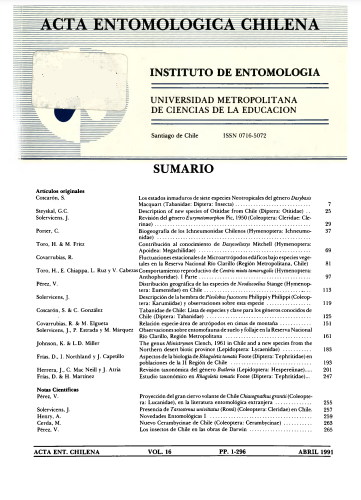Contenido principal del artículo
oct 28, 2022
Resumen
Centris mixta breeds in permanent nesting sites in a desert area of northern Chile. Males and females
exhibit little sexual dimorphism in size. Some males hover at aerial stations; this type of hovering flight
has no relation with mating behavior. The activity in the whole study area starts from 8.00 to 9.00 hr, at
a temperature of about 15° C. The few individuáis that do not spend the night in burrows, are the first
that start flying in the morning. By spending the night above ground, they remain exposed to low
temperatures and predators. From 10.00 to 11.00 hr, at a temperature somewhat lower than 30° C,
thousands of males patrol the nesting area; at the same time females start provisioning the nests. Males
fly more slowly against the wind, landing over the ground and forming groups that wait for an
emergent individual. While waiting, males fight in order to get as cióse as possible to the emerging bee
but they do not dig down toward the bee as occurs in C. pallida. Upon emergence of a new individual,
males aggregate around it; if the emerging bee is a female, one male takes her away from the group for
mating. While waiting in groups, males do not react well to environmental stimuli, and become prey
for several predators. Early in the morning males are more likely to emerge than females. The number
of male groups waiting for emerging individuáis, as well as the number of “mating balls” increases
from 1100 to 1200 hr. Reproductive activity over the ground ends from 1200 to 1300 hrs, at the time
when the soil surface temperature reaches 50° C. There are some shared behavioral patterns between
C. pallida (a North American species), and C. mixta, although the latter exhibts some distinctive traits.


